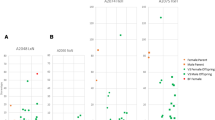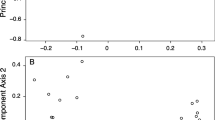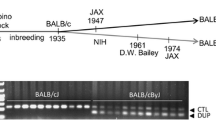Abstract
Peromyscus maniculatus (BW) and P. polionotus (PO) are interfertile North American species that differ in many characteristics. For example, PO exhibit monogamy and BW animals are susceptible to repetitive behaviors and thus a model for neurobehavioral disorders such as Autism. We analyzed these two stocks as well as their hybrids, a BW YPO consomic line (previously shown to alter glucose homeostasis) and a natural P. maniculatus agouti variant (ANb = wide band agouti). We show that PO animals engage in far less repetitive behavior than BW animals, that this trait is dominant, and that trait distribution in both species is bi-modal. The ANb allele also reduces such behaviors, particularly in females. PO, F1, and ANb animals all dig significantly more than BW. Increased self-grooming is also a PO dominant trait, and there is a bimodal trait distribution in all groups except BW. The inter-stock differences in self-grooming are greater between males, and the consomic data suggest the Y chromosome plays a role. The monogamous PO animals engage in more social behavior than BW; hybrid animals exhibit intermediate levels. Surprisingly, ANb animals are also more social than BW animals, although ANb interactions led to aggressive interactions at higher levels than any other group. PO animals exhibited the lowest incidence of aggressive behaviors, while the hybrids exhibited BW levels. Thus this group exhibits natural, genetically tractable variation in several biomedically relevant traits.




Similar content being viewed by others
References
Albert DJ, Walsh ML et al (1993) Aggression in humans: what is its biological foundation? Neurosci Biobehav Rev 17(4):405–425
Birdsall DA, Nash D (1973) Occurrence of successful multiple insemination of females in natural populations of deer mice (Peromyscus maniculatus). Evolution 27:106–110
Blair FW (1951) Population structure, social behavior, and environmental relations in a natural population of the beach mouse (Peromyscus polionotus leucocephalus). Contrib Lab Vertebr Biol, Univ Mich 48:1–47
Dawson WD, Lake CE et al (1988) Inheritance of burrow building in Peromyscus. Behav Genet 18(3):371–382
Dawson WD, Sagedy MN et al (1993) Growth regulation in Peromyscus species hybrids: a test for mitochondrial–nuclear genomic interaction. Growth Dev Aging 57(2):121–133
De Jong TR, Harris BN et al (2013) Physiological and neuroendocrine responses to chronic variable stress in male California mice (Peromyscus californicus): Influence of social environment and paternal state. Psychoneuroendocrinology. doi:10.1016/j.psyneuen.2013.03.006
Dewey MJ, Dawson WD (2001) Deer mice: “The Drosophila of North American mammalogy”. Genesis 29(3):105–109
Dewsbury DA (1988) Kinship, familiarity, aggression, and dominance in Deer Mice (Peromyscus maniculatus) in seminatural enclosures. J Comp Psychol 102:124–128
Duselis AR, Vrana PB (2007) Assessment and disease comparisons of hybrid developmental defects. Hum Mol Genet 16:808–819
Eisenberg JF (1968) Behavior patterns. In: King JA (ed) Biology of Peromyscus (Rodentia). Special Publication No. 2. American Society of Mammalogists, Stillwater, OK, pp 451–495
Foltz DW (1981) Genetic Evidence for Long-Term Monogamy in a Small Rodent, Peromyscus Polionotus. Am Nat 117(5):665–675
Foster DD (1959) Differences in Behavior and Temperament Between two Races of the Deer Mouse. J Mammal 40(4):496–513
Glasper ER, Kozorovitskiy Y et al (2011) Paternal experience suppresses adult neurogenesis without altering hippocampal function in Peromyscus californicus. J Comp Neurol 519(11):2271–2278
Güldenpfennig M, de Wolmarans W et al (2011) Cortico-striatal oxidative status, dopamine turnover and relation with stereotypy in the deer mouse. Physiol Behav 103(3–4):404–411
Hadley C, Hadley B et al (2006) Spontaneous stereotypy and environmental enrichment in deer mice (Peromyscus maniculatus): reversibility of experience. Applied Animal Behaviour Science 97(2–4):312–322
Hayssen V (1997) Effects of the nonagouti coat-color allele on behavior of deer mice (Peromyscus maniculatus): a comparison with Norway rats (Rattus norvegicus). J Comp Psychol 111(4):419–423
Kalueff AV, Tuohimaa P (2004) Contrasting grooming phenotypes in C57Bl/6 and 129S1/SvImJ mice. Brain Res 1028(1):75–82
Kalueff AV, Tuohimaa P (2005) Mouse grooming microstructure is a reliable anxiety marker bidirectionally sensitive to GABAergic drugs. Eur J Pharmacol 508(1–3):147–153
Kenney-Hunt J, Lewandowski AA et al (2014) A genetic map of Peromyscus with chromosomal assignment of linkage groups. Mamm Genome (in press)
Korff S, Stein DJ et al (2009) Cortico-striatal cyclic AMP-phosphodiesterase-4 signalling and stereotypy in the deer mouse: attenuation after chronic fluoxetine treatment. Pharmacol Biochem Behav 92(3):514–520
Lewis MH, Tanimura Y et al (2007) Animal models of restricted repetitive behavior in autism. Behav Brain Res 176(1):66–74
Linnen CR, Kingsley EP et al (2009) On the origin and spread of an adaptive allele in deer mice. Science 325(5944):1095–1098
Martin LB, Trainor BC et al (2007) HPA Activity and Neotic and Anxiety-Like Behavior Vary among Peromyscus Species. Gen Comp Endocrinol 151(3):342–350
Maxson SC (1996) Searching for candidate genes with effects on an agonistic behavior, offense, in mice. Behav Genet 26(5):471–476
Maxson SC, Didier-Erickson A et al (1989) The Y chromosome, social signals, and offense in mice. Behav Neural Biol 52(2):251–259
Miczek KA, Maxson SC et al (2001) Aggressive behavioral phenotypes in mice. Behav Brain Res 125(1–2):167–181
Moy SS, Nadler JJ et al (2007) Mouse behavioral tasks relevant to autism: phenotypes of 10 inbred strains. Behav Brain Res 176(1):4–20
Moy SS, Nadler JJ et al (2008) Social approach and repetitive behavior in eleven inbred mouse strains. Behav Brain Res 191(1):118–129
Muehlmann AM, Edington G et al (2012) Further characterization of repetitive behavior in C58 mice: developmental trajectory and effects of environmental enrichment. Behav Brain Res 235(2):143–149
Oriel RC, Wiley CD et al (2008) Adaptive Genetic Variation, Stress & Glucose Regulation. Disease Models and Mechanisms 1:255–263
Pennisi E (2013) Field test shows selection works in mysterious ways. Science 341(6142):118
Powell SB, Newman HA et al (1999) A rodent model of spontaneous stereotypy: initial characterization of developmental, environmental, and neurobiological factors. Physiol Behav 66(2):355–363
Robinson R (1981) The agouti alleles of Peromyscus. J Hered 72(2):132
Ryan BC, Young NB et al (2010) Social deficits, stereotypy and early emergence of repetitive behavior in the C58/J inbred mouse strain. Behav Brain Res 208(1):178–188
Shorter KR, Crossland JP et al (2012) Peromyscus as a mammalian epigenetic model. Genet Res Int. doi:10.1155/2012/179159
Tanimura Y, Yang MC et al (2010) Development and temporal organization of repetitive behavior in an animal model. Dev Psychobiol 52(8):813–824
Trainor BC, Lin S et al (2007a) Photoperiod reverses the effects of estrogens on male aggression via genomic and nongenomic pathways. Proc Natl Acad Sci U S A 104(23):9840–9845
Trainor BC, Rowland MR et al (2007b) Photoperiod affects estrogen receptor alpha, estrogen receptor beta, and aggressive behavior. Eur J Neurosci 26(1):207–218
Versteeg DH, Florijn WJ et al (1993) Synchronism of pressor response and grooming behavior in freely moving, conscious rats following intracerebroventricular administration of ACTH/MSH-like peptides. Brain Res 631(2):265–269
Vrana PB, Shorter KR et al (2013) Peromyscus (Deer Mice) as developmental models. WIREs Dev Biol. doi:10.1002/wdev.132
Walton JC, Chen Z et al (2013) Exogenous Melatonin Reproduces the Effects of Short Day Lengths on Hippocampal Function in Male White-Footed Mice, Peromyscus leucopus. Neuroscience. doi:10.1016/j.neuroscience.2013.06.020
Weber JN, Peterson BK et al (2013) Discrete genetic modules are responsible for complex burrow evolution in Peromyscus mice. Nature 493(7432):402–405
Wiley CD, Matundan HH et al (2008) Patterns of Hybrid Loss of Imprinting Reveal Tissue- and Cluster-Specific Regulation. PLoS ONE 3(10):e3572
Williams SA, Jasarevic E et al (2013) Effects of Developmental Bisphenol A Exposure on Reproductive-Related Behaviors in California Mice (Peromyscus californicus): a Monogamous Animal Model. PLoS ONE 8(2):e55698
Acknowledgments
We thank Charlie Lawrence for discussions in developing these studies. We thank Noldus representative Wilant van Giessen for analysis suggestions and trial of the Observer software. The study was funded by NIH P40 OD 010961.
Author information
Authors and Affiliations
Corresponding author
Additional information
Edited by Stephen Maxson.
Electronic supplementary material
Below is the link to the electronic supplementary material.
Supplementary material 1 (WMV 62792 kb)
Rights and permissions
About this article
Cite this article
Shorter, K.R., Owen, A., Anderson, V. et al. Natural Genetic Variation Underlying Differences in Peromyscus Repetitive and Social/Aggressive Behaviors. Behav Genet 44, 126–135 (2014). https://doi.org/10.1007/s10519-013-9640-8
Received:
Accepted:
Published:
Issue Date:
DOI: https://doi.org/10.1007/s10519-013-9640-8




